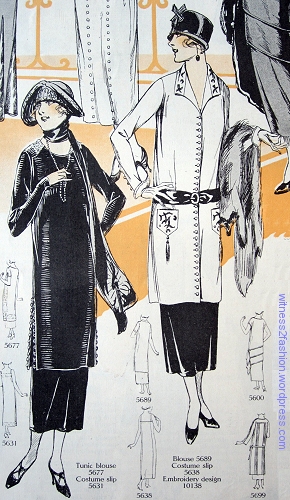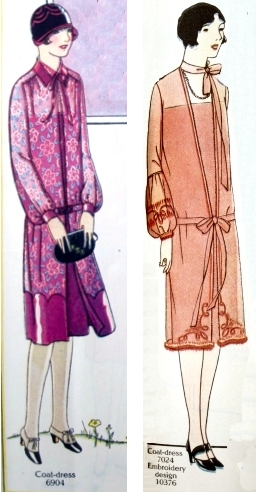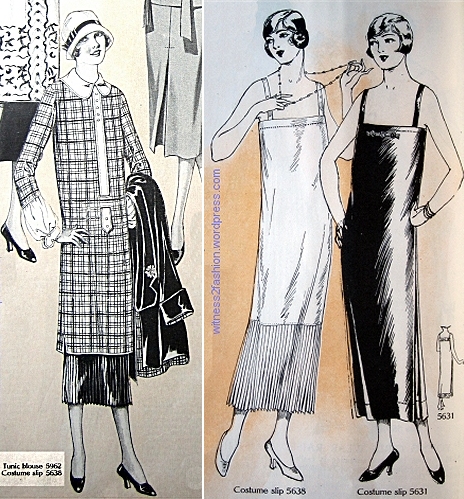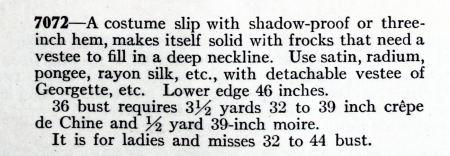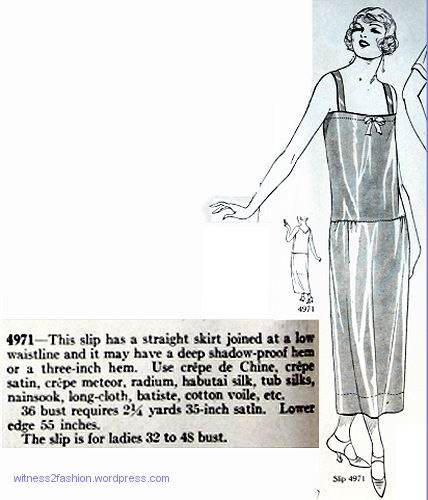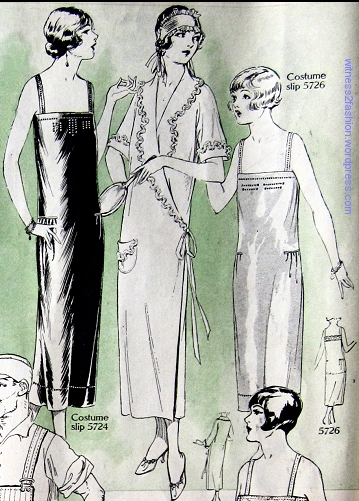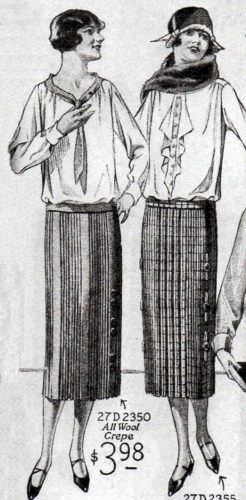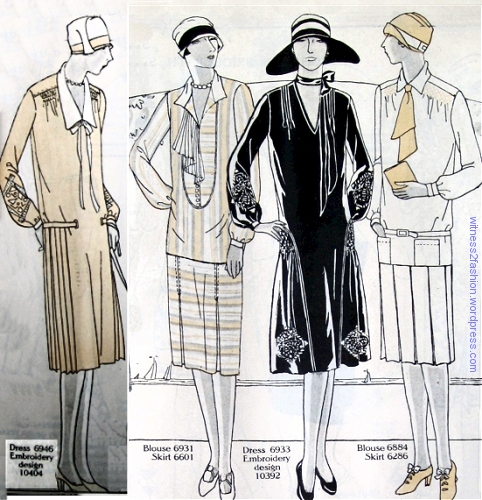Costume Slips
I kept noticing the phrase “costume slip” in combination with “tunic blouse,” but even after finding several examples in Butterick lingerie patterns, my definition will be deduction and guesswork. I’m tempted to define a “costume slip” as “a slip-like garment that is intended to be seen.”
That is, the costume slip may be seen below a tunic blouse . . .
or under a sheer fabric like lace, voile, chiffon or georgette. . .
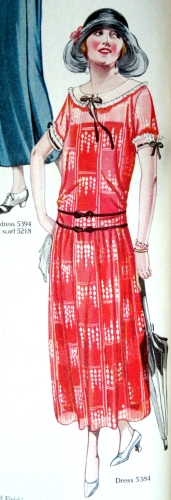
Butterick pattern for a sheer day dress, probably cotton voile, Aug. 1924. Such a dress needs a coordinating slip.
. . . or perhaps revealed by a coat dress that is open down the front, although these two dress patterns apparently included their own slip patterns.

“To wear under tunic blouses and transparent dresses . . . .” [I have not seen a lace-trimmed slip illustrated with a tunic blouse.] Costume slip pattern #5685, Butterick, Dec. 1924. Available up to bust size 52″.
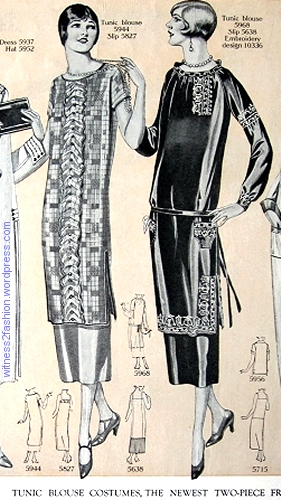
Tunic blouses with “open edges”, April 1925. Delineator. Costume slip #5638 — this time without pleats — is on the right.
To see more “tunic blouse costumes,” click here.
This 1926 costume slip could be made with a detachable front, called a vestee, to take the place of a blouse under a very low V-necked dress, a coat dress, or a suit jacket.
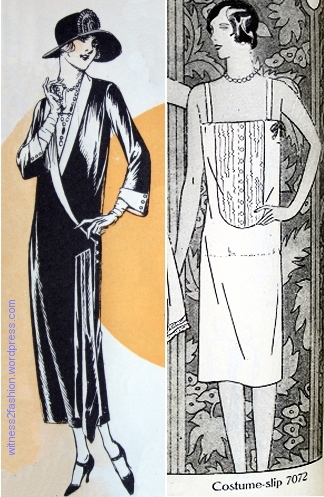
A coat dress with low front, Nov. 1924; a costume slip (Butterick #7072, from 1926) could take the place of a blouse.
Women over forty may remember a more recent vogue for colorful, knit tank tops or camisoles with appliqued lace at the neckline, which served the same purpose.
Costume Slips or Lingerie Slips?
Lingerie slips, made of translucent silk, might have a “shadow-proof” hemline (i.e., two thicknesses of fabric) so that a woman could stand in a doorway with the light behind her and not have her legs visible though her clothes. This embarrassing photo of Lady Diana Spencer, later a fashion icon, shows why wearing an opaque slip can be a good idea.
The more images of costume slips I found, the more confused I got. This seems to be a lingerie slip, made of light silk or cotton — intimate apparel. But crepe satin and radium [a lustrous silk] were also recommended for costume slips.
You would think a slip trimmed with lace is obviously a lingerie slip, not intended for public view. However, I was forgetting that the same pattern could be used for a costume slip or a lingerie slip –– depending on the fabric used: heavy, opaque silks for costume slips, and sheer China silk, batiste, cotton voile, etc., with optional lace, for intimate apparel.
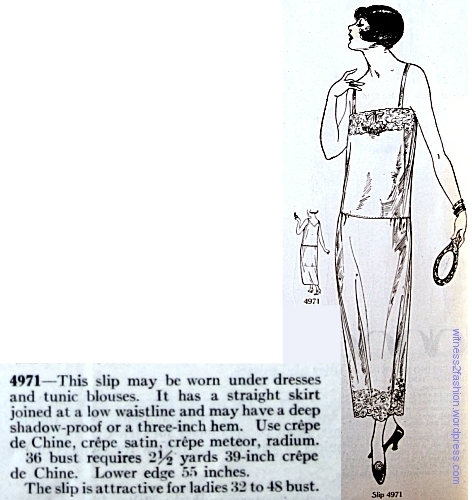
Butterick slip pattern 4971, January 1924, would make either a costume slip or a slip that was only revealed in private. The small illustration shows it untrimmed and with a deep, shadow-proof hem.
“Radium” refers to radium silk, not radioactive silk. Crepe meteor seems similar to modern crepe-backed satin.
Butterick 5724: “This costume slip with a straight lower edge and a three-inch or deep shadow-proof hem, is an especially good design. Use soft satin, crepe meteor or crepe de Chine under tunic blouses, or these materials or sateen under transparent dresses, and radium silk, habutai silk, glove silk, silk jersey or sateen, under non-transparent dresses.” Notice how deep the shadow-proof hem is!
Skirts versus Costume Slips
To add to the confusion, 1920’s skirts were often made without a waistband, and attached to a slip-like bodice instead, so that the skirt was suspended from the shoulders and needed no darts or waist shaping. But they are not “costume slips.” They are skirts intended to be worn with hip-length overblouses, not longer “tunic” blouses, and the skirts are usually made from wool or broadcloth, not silk. The bodice could be inexpensive silk, cotton, or rayon.
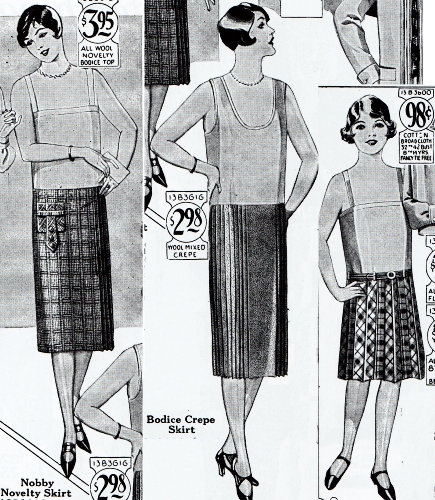
1920’s skirts suspended from a bodice. 1927-28. From Stella Blum’s Everyday Fashions of the Twenties.
This method of suspending a pleated skirt gives a perfectly straight, authentic twenties’ line. Wearing a twenties’ blouse or sweater over a modern skirt is less effective. Some 1920’s skirts were constructed with a waistband, but it did not ride snugly at the natural waist, so those skirts probably migrated around the body when worn. It must have been difficult to keep the blouse tucked in.
Also, with a waistband, the skirt waist is necessarily higher than the “fashion waist” of the late twenties.


